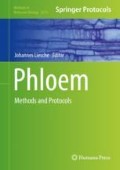Abstract
Electropotential waves (EPW) are involved in plant responses to both abiotic and biotic stresses. Three different types of EPWs have been identified: action potential, variation potential, and system potential, all of which have been indicated to participate in phloem-based communication between plant organs. In this chapter we describe in detail how to measure EPWs in plants, including how to access the phloem, and how to insert microelectrodes. Such experiments can be used, for example, to study the local and systemic signaling in response to diverse stimuli like microbial threat or herbivore attack.
Access this chapter
Tax calculation will be finalised at checkout
Purchases are for personal use only
References
Hafke JB, van Bel AJE (2013) Cellular basis of electrical potential waves along the phloem and impact of coincident Ca2+ fluxes. In: Thompson GA, van Bel AJE (eds) Phloem. Molecular cell biology, systemic communication, biotic interactions. Wiley, Chichester, pp 122–140
Fromm J (1991) Control of phloem unloading by action potentials in Mimosa. Physiol Plant 83:529–533
Fromm J, Spanswick R (1993) Characteristics of action potential in willow (Salix viminalis L). J Exp Bot 44:1119–1125
Fromm J, Bauer T (1994) Action potentials in maize sieve tubes change phloem translocation. J Exp Bot 45:463–469
Rhodes JD, Thain JF, Wildon DC (1996) The pathway for systemic electrical signal conduction in the wounded tomato plant. Planta 200:50–57
Furch ACU, van Bel AJE, Fricker MD, Felle HH, Fuchs M, Hafke JB (2009) Sieve-element Ca2+ channels as relay stations between remote stimuli and sieve-tube occlusion in Vicia faba. Plant Cell 2:2118–2132
Zimmermann MR, Mithöfer A, Will T, Felle HH, Furch ACU (2016) Herbivore-triggered electrophysiological reactions: candidates for systemic signals in higher plants and the challenge of their identification. Plant Physiol 170:2407–2419
Davies E (2004) New functions for electrical signals in plants. New Phytol 161:607–610
Felle HH, Zimmermann MR (2007) Systemic signalling in barley through action potentials. Planta 226:203–214
Zimmermann MR, Mithöfer A (2013) Electrical long-distance signalling in plants. In: Baluska F (ed) Long-distance systemic signalling and communication in plants. Springer, Berlin, pp 291–308
Stahlberg R, Cosgrove DJ (1996) Induction and ionic basis of slow wave potentials in seedlings of Pisum sativum L. Planta 200:416–425
Stahlberg R, Cosgrove DJ (1992) Rapid alterations in growth rate and electrical potentials upon stem excision in pea seedlings. Planta 187:523–531
Zimmermann MR, Maischak H, Mithöfer A, Boland W, Felle HH (2009) System potentials, a novel electrical long-distance apoplastic signal in plants, induced by wounding. Plant Physiol 149:593–600
Furch ACU, Hafke JB, Schulz A, van Bel AJE (2007) Ca2+-mediated remote control of reversible sieve tube occlusion in Vicia faba. J Exp Bot 58:2827–2838
Acknowledgments
We are grateful to Michael Thorpe for proofreading and helpful comments. This work was supported by the Deutsche Forschungsgemeinschaft (grant FU969/2-1 to ACUF and MRZ) and the Max Planck Society, Germany (MKP).
Author information
Authors and Affiliations
Corresponding author
Editor information
Editors and Affiliations
Rights and permissions
Copyright information
© 2019 Springer Science+Business Media, LLC, part of Springer Nature
About this protocol
Cite this protocol
Zimmermann, M.R., Hafke, J.B., Paulmann, M.K., Furch, A.C.U. (2019). Measurement of Electropotential Waves in Intact Phloem Sieve Elements Using Microelectrodes. In: Liesche, J. (eds) Phloem. Methods in Molecular Biology, vol 2014. Humana, New York, NY. https://doi.org/10.1007/978-1-4939-9562-2_34
Download citation
DOI: https://doi.org/10.1007/978-1-4939-9562-2_34
Published:
Publisher Name: Humana, New York, NY
Print ISBN: 978-1-4939-9561-5
Online ISBN: 978-1-4939-9562-2
eBook Packages: Springer Protocols

